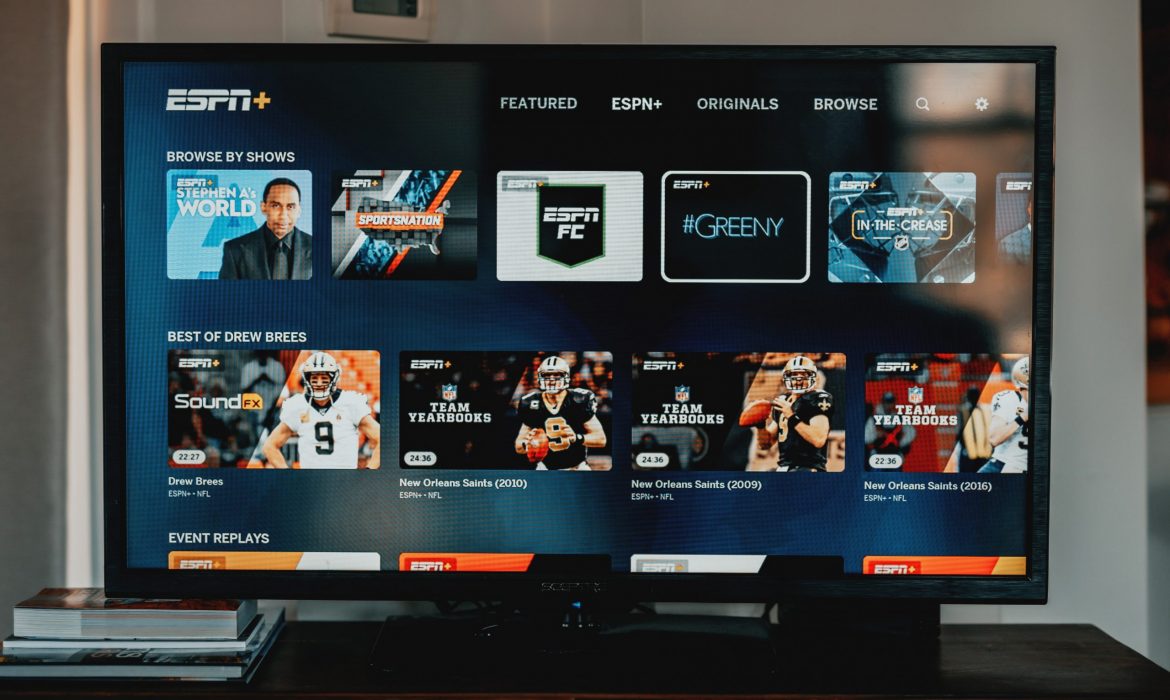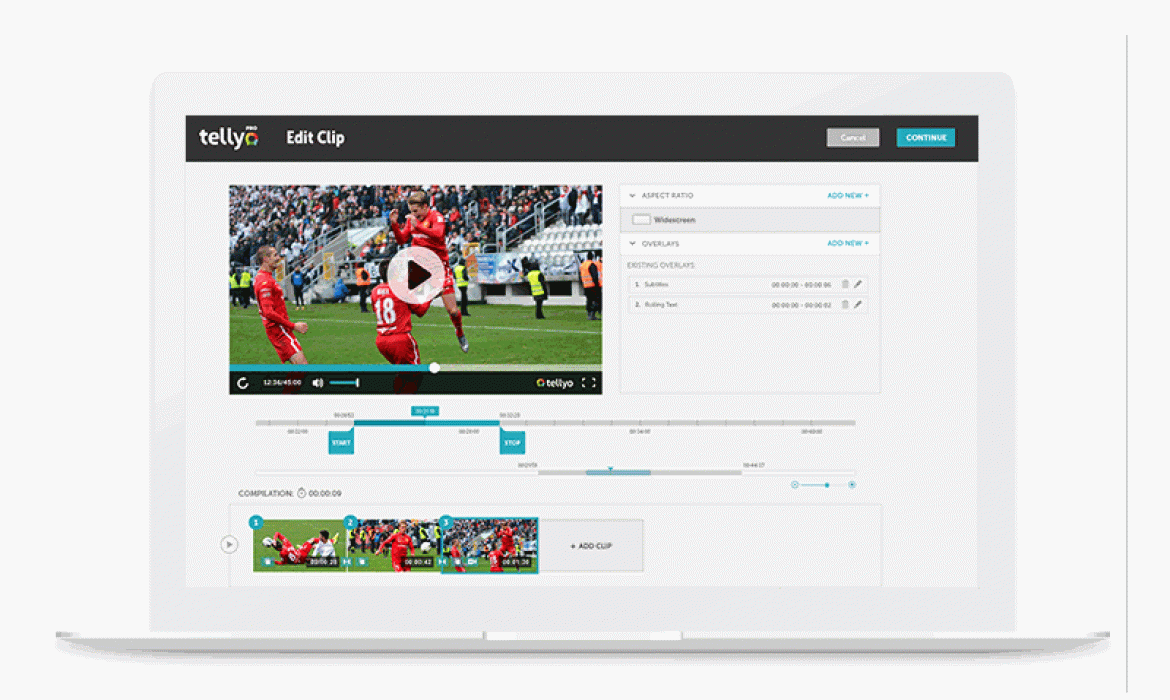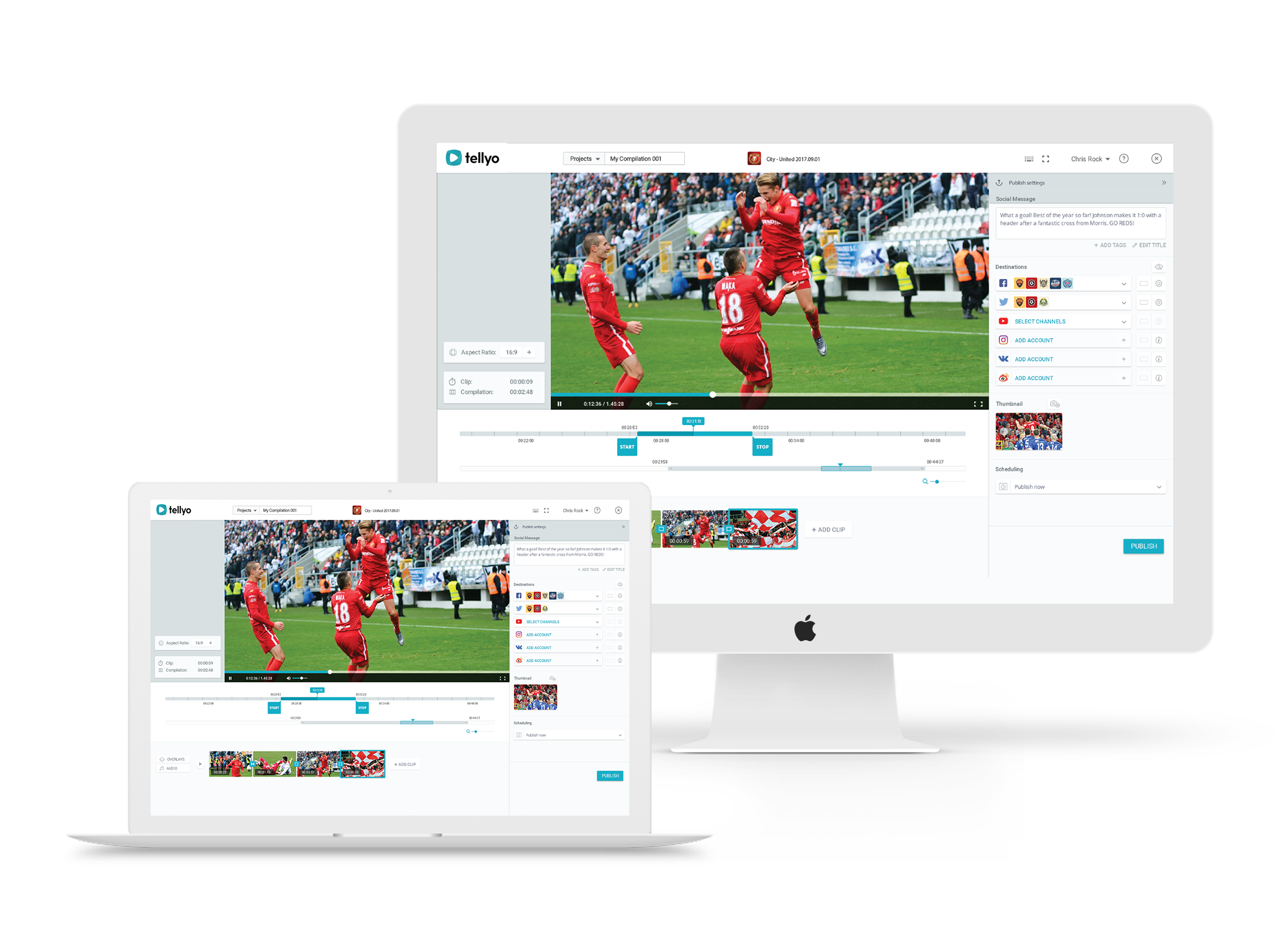5 convincing reasons you should stream esports
If you were to ask someone – what’s your favourite sport? – the answer would likely be one of the following: football, basketball or cricket. However, this status quo is changing even as I write this blog. That’s because we have a new player in town: esports!
Esports (electronic sports) is best described as competitive, multi-player video gaming. Puzzled? Not really convinced by this whole gaming thing? Here are five reasons to change your mind. By the end of this article you’ll be considering your options!
#1 Gaming is mainstream
Believe it or not, gaming is mainstream. No longer a hobby of geeky teenagers (if it ever was), it is one of the most popular ways to spend leisure time – next to watching TV, reading books or actively taking part in sports.
According to research, 67% of US households own a device that is used to play video games.[1] To compare – 58% of American households has one or two televisions, and 39% three TV sets or more[2] (obviously with some overlap between these two figures).
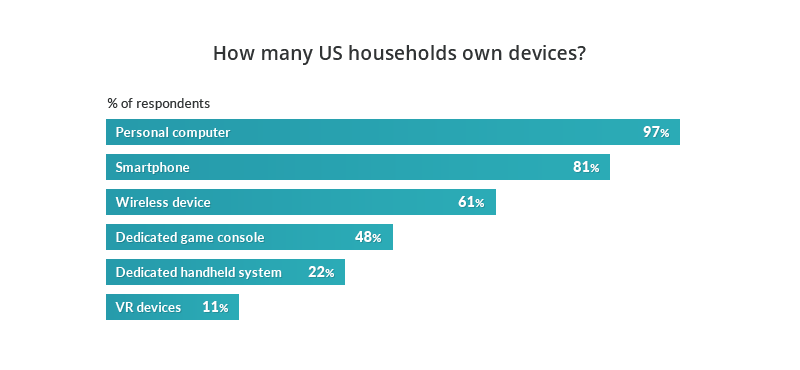
If you also look at the above device ownership stats, these point to changing trends in the tech used for leisure and entertainment. Traditional TV is also on the out as the cord cutting trend continues.
Gaming is part of these wider trends – an obvious example being a TV set used for gaming rather than for watching prescribed TV stations.
All around us we can see how gaming itself is more and more visible in media and culture. Think movies (Resident Evil, TRON, Warcraft, Wreck-It Ralph), magazines (thousands of titles around the world), TV series (frequent video games references in Futurama, South Park, Stranger Things, The Big Bang Theory) and even the advertising world. Game developers are not only buying adverts in digital media, nowadays you can see their ads on mainstream TV as well. The list could go on and on.
To cut a long story short – gaming is everywhere and it’s only just beginning!
#2 Esports stats are BIG
Esports events attract colossal amounts of people – both offline and online. Fans include a large proportion of millennials and Gen Zers, both demographics often difficult to access
Esports events attract colossal amounts of people – both offline and online. Fans include a large proportion of millennials and Gen Zers, both demographics often difficult to access. But research also highlights more surprising fan stats – they are often high earners, 38% are women and 58% of fans over 25 have children of their own.[3].
There are multiple leagues and tournaments focused around the most popular online games, like Dota 2, Hearthstone or FIFA and the PES series. Thanks to sponsors, esports players and teams are competing in big venues to massive audiences (both at the venue and online) and for serious money. Figures from SuperData Research suggest that $662million of sponsorship money was injected into esports during 2016[4].
In 2017, at the annual International Dota 2 Championships event in Seattle, players won prizes totalling… $24,687,919! [5]
One of the most recognisable esports events in the world – the Intel Extreme Masters (IEM) – engages thousands at the actual event and millions more during digital broadcasts. Held in 2017 in Katowice, Poland, organisers claim that the event was the world’s biggest esports event in history[6].
Here are some stats from the IEM event, which was mainly focused around League of Legends (LoL), Counter Strike: Global Offensive (CS:GO) and Starcraft II.
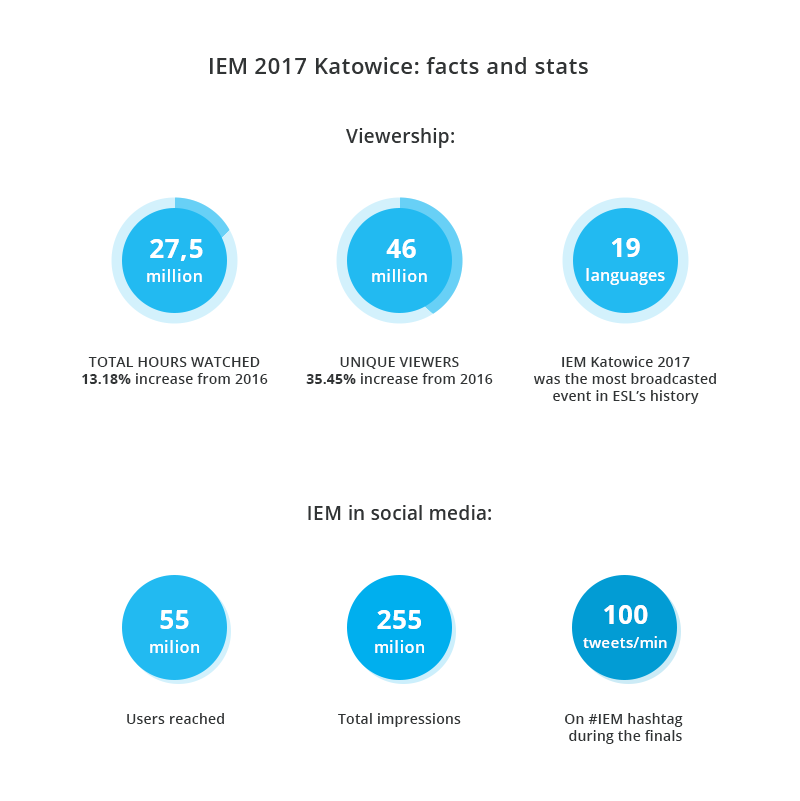
Just for comparison: Donald Trump’s 2017 inauguration was watched by 30.6million TV viewers, so 10 million more viewers watched IEM’s esports event.[7]
#3 Natively digital and hugely dynamic
With all the action taking place online, esports are natively digital – a natural environment for gaming and related content.
The biggest digital space in the esports streaming world is Twitch.tv – a digital broadcasting platform that specialises in showing content produced by gamers, for gamers. Bought by Amazon in 2014, Twitch is the first choice for players who want to stream their gameplays and even earn money from donations from fellow players. It is undoubtedly the most popular among players, but sometimes more suited to experienced insiders already familiar with the gaming world.
Linear TV stations are increasingly seeking a piece of the action. ESPN, BBC, SkySports and Poland’s Polsat are amongst the traditional broadcasters investing in the dynamic esports market in some way: streaming events or distributing related content online. These linear broadcasters are proving savvy in the way they’re using digital platforms, such as dedicated web pages and social media, to support their efforts and engage the esports audience. They understand that esports are digitally native and any supporting content must be digital as well. It’s as simple as that.
#4 Video content is integral
Digital streaming platforms like Twitch are undoubtedly spearheading the popularity of esports. What’s also really interesting is that gamers like to watch other gamers; while fan audiences are on the rise due to the exciting content on offer. Watching can be a roller coaster of emotions, just like every other sport, and the passion of fans is obvious.
Video is integral to this and YouTube is an extremely popular place for both gamers and fans to watch esports video content. Here are some interesting insights from Google:
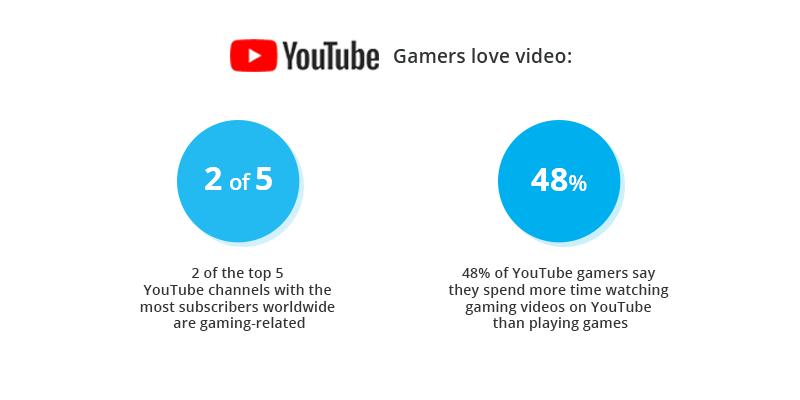
#5 A growing and engaging market
The value of the global video game market reached over $101billion in 2016 and will hit $128billion+ by 2020[8]. These staggering figures include PC, console and mobile games and point to one thing – people are simply crazy about games! More and more people are spending time and money to play them.
This isn’t a passive market though. Esports fans and players are highly engaged, keenly watching what’s going on in esports, following their own favourite players and teams. Esports are also very interactive – when playing and watching people chat, comment and interact, becoming part of a community of like-minded fans.
So, while they are interested in the most popular Triple-A titles and online games, fans will also be watching esports in their feeds, or practicing their own skills to develop as a gamer, or publishing their own gaming videos as a YouTuber.
The ball is in your court
Beyond doubt, esports is a hot topic. It involves millions of people playing, streaming and watching. The numbers are often staggering and, in many cases, the popularity of this kind of digital entertainment has already exceeded the popularity of ‘analogue’ sports. This represents a huge opportunity for sports broadcasters to get involved in this nascent market, while it’s still fresh and there’s still time.
[1] Source 1 , [2] Source 2, [3] Source 3, [4] Source 4, [5] Source 5, [6] Source 6, [7] Source 7, [8] Source 8
The new look Tellyo – More power to the user
Here at Tellyo, we take the time to listen to what users have to say and genuinely care about your needs. The new look Tellyo, which we will be gradually rolling out to our users, is the ultimate proof – a refreshed, user-friendly interface, packed with new features and enhancements.
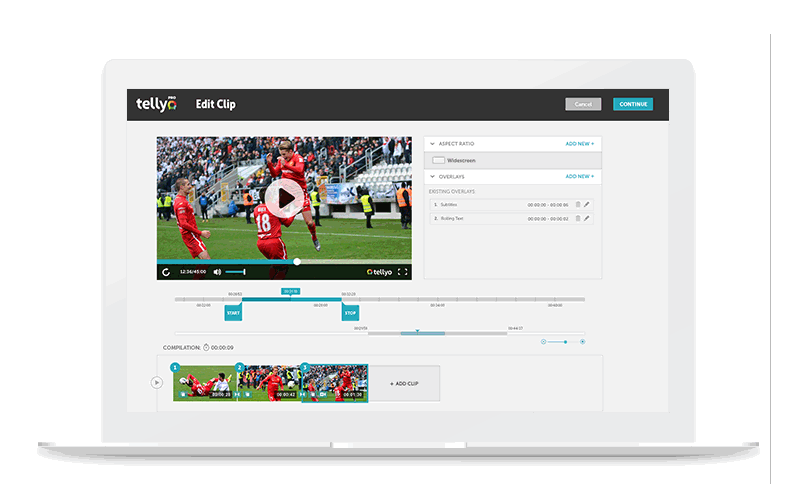
Let’s take a closer look at what we’ve improved for you:
Reach your audiences even sooner
Online audiences value getting information instantly. That’s why we’ve improved the workflow for producing clips and sharing them to social media.
From now on, editing and sharing will happen on the same screen, making the process faster and more fluent.
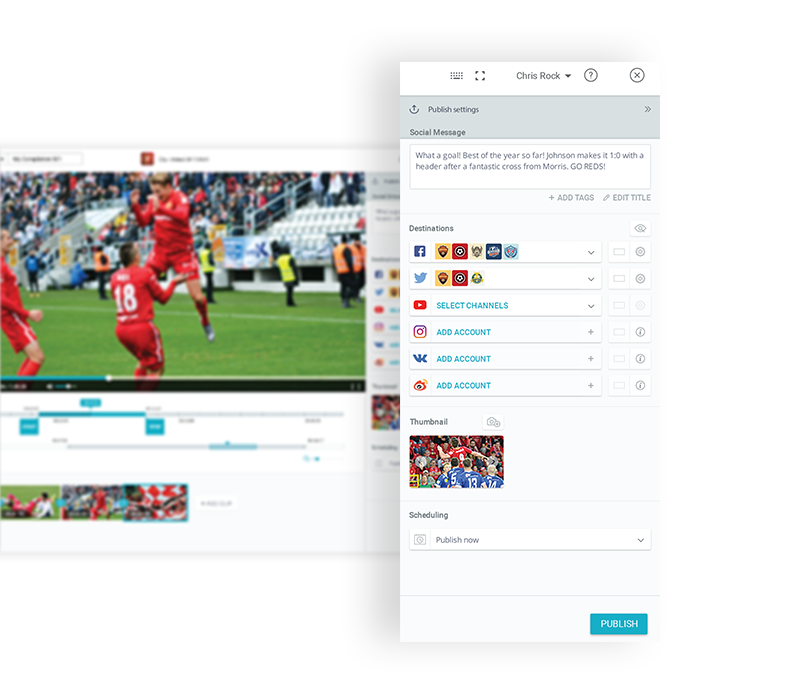
Sharing a single clip of a key moment takes seconds. While producing an engaging video with branded overlays, bumpers and wipes, then simultaneously publishing it to multiple social media profiles takes less than one minute.
With such a fast workflow at your fingertips, you can reach your audience as soon as possible and maximise engagement.
Boost productivity with the new Projects feature
By listening to our customers we gained useful insights. We found that switching between tasks when working with live content, is something that users do a lot. When switching, users wanted certainty that their work would be saved.
To meet their needs, we’ve created the Projects feature. Each task now started in Tellyo will be automatically saved as a separate Project. This means that users can jump into other tasks and get back to saved work whenever they want. The clip, compilation or highlights will simply be waiting for them, just as they left it.
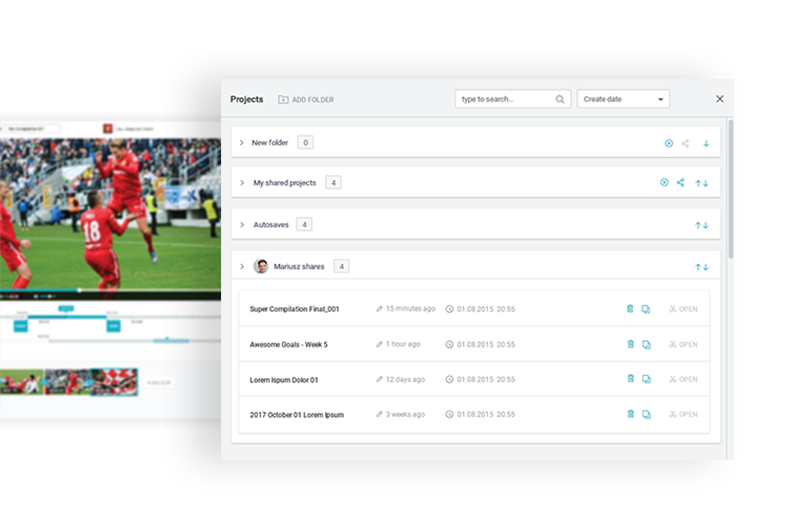
Projects can also accelerate the process of creating different types of highlights and can improve collaboration among users with access to the same content in Tellyo. You will be able to automate some of your frequent activities helping you to keep your content more consistent and faster to produce.
Publish smarter on social media
Effective distribution of content to social media can be difficult at times, especially when collaborating with external partners, like freelancers or agencies. This is something we’ve addressed and simplified with the new look Tellyo.
Via Tellyo, you can now safely give limited access to your social media profiles to chosen users – such as trusted, independent freelancers.
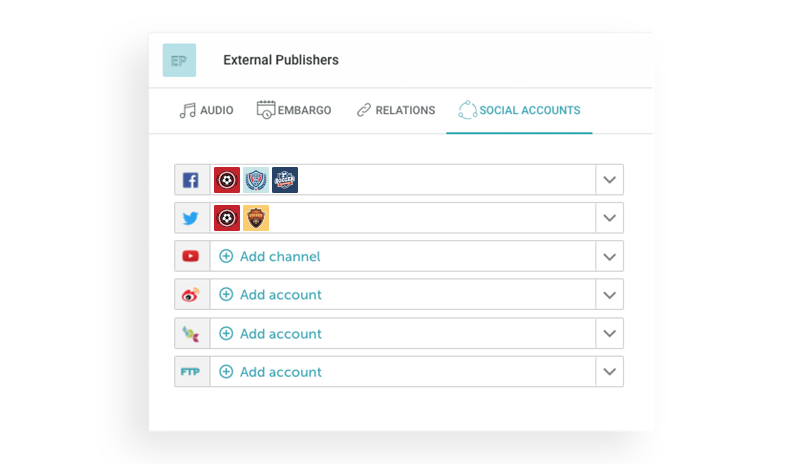
You can allow them to publish and stream content on your social media channels through Tellyo, but without giving them actual, wider access to your social media accounts.
This way, we keep your social accounts safe but operational for users you choose.
Design suited to your needs
We were surprised to see that our customers use Tellyo on such a wide range of screen sizes and that they often work in resized browsers. To make it easier and efficient, we’ve redesigned our platform and made it more responsive.
You can now work more effectively in Tellyo when on smaller laptop screens or in resized browsers.
Learn how to use Tellyo with our new Guide
Every Tellyo customer will now gain access to our knowledge base – the Tellyo Guide. This puts how-to guidance at our customers’ fingertips and will help to answer the most common questions related to Tellyo features.
You can search through the Guide’s topics or categories – it’s up to you. If you’re unable to find a satisfactory answer, simply let us know. We’re always keen to get to know your point of view and help you.
If you’re already a Tellyo user – simply click here to login to the Guide. If you wish to become a customer, please contact us.
When will the upgrades be available for users?
We are rolling out the upgrades gradually and will contact each of our partners individually to make this process as comfortable as possible.
Not the final word!
We’re proud of Tellyo’s brand-new UI. But we’re not going to stop here. All improvements are the result of continuous dialogue with our users.
The new design also allows us to efficiently develop the platform further, so stay tuned.
If you have any suggestions about new features that could be added to Tellyo, we would be more than happy for you to reach out to us via contact@tellyo.com.
What indicates success? The social video KPIs that count
Ok, so you’ve broadcasted another video to Facebook… Surely you gained some likes, comments and shares. But is that all you should expect? What really indicates success?
To help you measure outcomes, here are the indicators you should take into account. Let’s take a closer look.
Views
These are a very informative but basic indicator. Views are the most popular way to measure the success of video content and every social platform will provide this information. But views don’t tell the whole story. They’re more like the first chapter – a small glimpse at how your video is performing. So, [bctt tweet=”when choosing KPIs for your video strategy, don’t just stop at views.” username=”TellyoTV”]
Subscribers or Followers
The name of this indicator can vary from platform to platform. However, it’s one of the most vital ratios, with the number of people following your social channels hugely impacting other KPIs. When creating a video or broadcasting strategy, you should include fan, follower or subscriber growth, and ratios to other KPIs such as views.
Learn how to incorporate sponsorship into your real-time social videos
To increase subscribers, for example, remember to use call to actions (‘Subscribe to our channel!’), or subscribe buttons within a video and a link within its description.
Drop off rate
This indicates how many people watched your video and dropped off after 5, 10 or 30 seconds. It’s absolutely natural for this KPI to drop initially during some of your first attempts at video, but there are many practical things you can do to decrease drop off rates.
To do so, you might shorten video intros and cut the length in general to condense your message.
Watch your video one more time before publishing. Ask yourself: Does it need shortening? Does it get to the point quickly enough? Where’s the beef?
Conversion rate
This indicates how efficient your content is, but it’s rarely linked with video marketing or broadcasting in general. Whether you decide to include in your KPIs will depend on your goals. For example, if you wish to increase the number of subscriptions to your video service, and video is your main content, you may want to include this KPI in your quarterly or yearly marketing strategy.
You can convert viewers into subscribers, or even new customers, in many ways:
- Include call to action buttons in your videos. Play with the copy and design to test what works best for you.
- Remember to add call to actions and links with your video descriptions too.
- Use specially created email addresses and phone numbers to measure the direct impact of your videos on business enquiries.
It’s up to you!
No matter what set of KPIs you decide to measure, always give yourself time.
Collect the data over a reasonable period, which will enable you to see the whole picture and insightful patterns.
If you’re already using Tellyo – check out our Analytics section to see insights related to your content. Using our platform you also have access to other features, all of which are designed to make your content better and more attractive to viewers… so helping to boost your KPIs.
Going social with your broadcasts: the basics
Back in the day, when Facebook was on the rise, every business owner wanted to be there ‘because everyone’s there’. The social network was soon flooded with aesthetically poor and awkwardly positioned business profiles, most of which were instantly forgotten.
The lesson we can all take from back then, at the beginning of the Facebook hype, is that it’s not enough to just be in the right place. In order to gain social media results, you need to remember why it’s good to be there and how to do things right.
So, let’s start with some basics, so you can ensure your video presence on social media is professional, striking and memorable.
Social media broadcasting is dialogue
Many organisations deciding to make the leap to social media often forget one basic principle: social media is all about dialogue between brands and fans.
So, when you start posting your videos to social media, don’t be surprised by the amount of feedback you receive. It’s not enough to simply stream great content, you must be prepared to handle the reactions of your community – positive or negative.
Prepare your social media team to expect the unexpected, such as difficult questions, spammy comments and harsh language, much of which you’re likely to encounter.
Roll with it… it’s not a such a bad thing
A traditional broadcast is controlled by a TV station, while video on social media can develop a life of its own even after being broadcast to a social channel. Once transmitted to the web it could be re-shared thousands of times, rippling out to more and more fans in the process.
What this does raise are questions about how to ensure your branding remains while your content extends its reach. The good news is that there are many useful things you can do to protect and secure branding on your content, such watermarks and bumpers.
Protect your rights by branding your content with watermarks, overlays, wipes and bumpers. Tellyo can help you to do this.
Broadcast is dead, long live the broadcast!
In the world of social media, a broadcast is not a singular event. From broadcasted content, you can create multiple, independent video clips for different social channels, different time zones, and in different languages for different audiences. You can recycle content by creating clips, highlights and compilations.
Thanks to Tellyo, you can even create cool clips during a stream; while also being able to create longer video compilations by joining clips from your live stream with older content created from other sources.
Let your social media folks get creative and play with content. Bring it to life one more time!
Timing is everything (duh!)
In professional broadcasting, especially in sports, timing is crucial. Being able to clip and share a replay to Facebook and YouTube is everything. You can be sure that the first brand to replay a goal or a golden moment will build more reach and grab new viewers within seconds.
If you can automate content production to gain speed, don’t hesitate to do it. In Tellyo, for example, you can ensure branded bumpers are immediately added to all content as part of your workflow.
One more thing…
There’s no simple or perfect recipe for success. Just be prepared and open minded.
If you’re looking for a tool that will help you quickly move beyond the basics and reach new heights with social media, check out Tellyo’s features and our case studies.
Digital video publishing: big challenges, simple solutions
Digital video publishers have spoken about the challenges they face in an insightful report from Wibbitz: Winning strategies for digital video.
Through its findings, having surveyed the company’s American and European publishing partners, Wibbitz have been able to identify the challenges proving hardest to overcome.

But for every challenge faced, there’s always a solution. And here I want to look at the top four challenges, and how our Tellyo platform can help you overcome your pain by offering some simple fixes.
Human resources
The major challenge for many video publishers is simply having people in place to produce and distribute content. The reality of many people being involved in video production may sound familiar to you? It’s something we often hear from businesses here at Tellyo.
Potential customers often tell us how they have separate teams for production and for social media, all trying to manage a technically demanding process. Our response is always the same: it needn’t be this way.
Our Tellyo platform democratises video editing, negating the need for tons of specialist and expensive kit, while making the whole process easier and quicker for your people to manage. Tellyo will make video publishing easier and less resource consuming, but not less powerful. Ultimately, you will be able make more brilliant content with the same human resources.
Monetisation
You may be finding that it’s pretty easy to reach decent levels of video views, since platforms like Facebook clearly favour video over other content types. But what comes next? What to do with your hundreds, if not thousands, of video views? Well, you’re not alone in asking such questions. Monetisation was the second biggest challenge highlighted by Wibbitz survey respondents.
With Tellyo, you can monetise your video content very easily using our platform’s features. These include pre- and post-roll advertisements, and branded video players. All of which can be included when you share video content or stream it to different social platforms via Tellyo.
For businesses that are not yet utilising video content – if you move swiftly, you will boost your chances of capturing the attention of new and existing audiences through the video content they desire. This will help you to create monetisation opportunities further down the line. Which leads nicely to my next point…
Quantity and scale
Because there’s huge demand for video online, businesses want to be able to deliver the quantity and scale that’s required. To cut a long story short, Tellyo helps you to scale production in a very short space of time. For example, our easy to use workflow can be rapidly integrated into and adopted by a business.
Quantity is also extremely important. As an example, let’s take a look at an analysis of one of our customers, the International Table Tennis Federation (ITTF).
There’s strong correlation between number of videos shared by the ITTF and engagement rates:
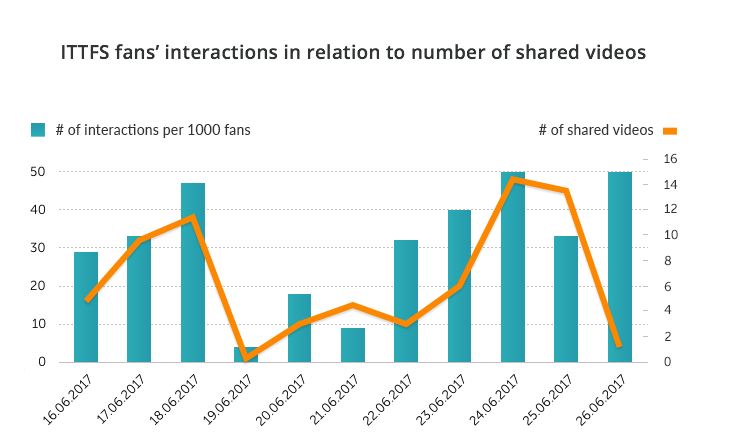
Simply put: the more you share, the more likely you are to achieve greater engagement.
Maintaining quality and standards
It can be a challenge to pay attention to quality if there’s no time to waste and your main competition never sleeps. Tellyo addresses this by delivering tools that help maintain fast-paced video production, while empowering you to communicate a consistent and coherent brand story through well-packaged videos.
To do so, we make it easy for your team to work together. Using highly-reliable Amazon solutions, Tellyo is cloud-based platform which makes it easy to access for the people involved in a project. What’s more, our platform makes it possible to fit video production to the different software and hardware requirements you might be working with. This means you can provide high-quality content fitted to different standards and expectations.
For example, Tellyo can digest various sources, such as HLS, RTMP, satellite streams and TV Exchange Points. It will also work with the most popular social and video networks, like Facebook, YouTube, Twitter, Instagram, but also Brightcove or custom destinations.
When it comes to working with our customers, we’re pretty flexible here at Tellyo.
We’re always open to new challenges and more than ready to provide solutions fitted to the specific challenges you face. Our platform is also geared towards empowering you as a digital video publisher, so you can focus on the quality of your content, rather than on technical or organisational obstacles.
Please get in contact to discuss your challenges and how we can help.
A recipe for video content success: Lonzo Ball and the Summer League buzz
While it’s not everyone’s favourite, partly due to being played in the silly season, this year’s NBA Summer League was truly special. Lonzo Ball was the star earning MVP status on the court, while his father courted controversy off it. The surrounding buzz led to record viewing figures – with six of ESPN’s seven most-viewed games featuring the LA Lakers draft star.
ESPN proved willing to run with the Lonzo hype and the buzz his father, LaVar, was able to build around him. The channel struck gold with the duo, and their presence helped to build a buzz around the Summer League.
Some of the factors that helped build a buzz:
- A superstar in the making
There’s no doubt, Lonzo is a superstar on the rise. He has outstanding skill and is an unusual size for his position, which makes him an interesting proposition. It didn’t hurt that he brought passion and emotion to the court in front of big crowds in the stands and on TV, making him the Summer League’s Most Valuable Player.
- Lonzo, the lead story
Matching his performances, Lonzo maintained a position as the most written-about player throughout the Summer League. Media Cloud stats tell the story – he outpaced other players with 702 mainstream news stories, more than the 2nd and 3rd players combined.
- LaVar, a slice of controversy
There’s no doubt that “a ton of the attention Lonzo receives stems from his brash, outspoken father, LaVar,” according to a fantastic article on the FiveThirtyEight website. As he tried to bolster his family’s brand value any way he could, one of LaVar’s standout comments was to claim he was a better basketball player than Michael Jordan. Tweeters used #lavarballsays to mock him (ironically adding more fuel to the selfless promotion of the Ball name).
- The media were kept guessing
With Lonzo yet to sign a shoe deal with one of the major brands, masses of media attention surrounded what sneakers he would wear. This speculation was only encouraged by the Ball family releasing their Big Baller Brand shoes. So every time Lonzo put on a different pair of sneakers, people would be asking is it another marketing ploy?
What was the recipe for ESPN’s success?
ESPN fully capitalised on the buzz surrounding the Summer League. By combining TV broadcasts with video content and social media activity, the channel was able to engage its audience and even make some good gains. For example, 2017 Google Trends data shows huge increases in searches related to ‘NBA Summer League’.
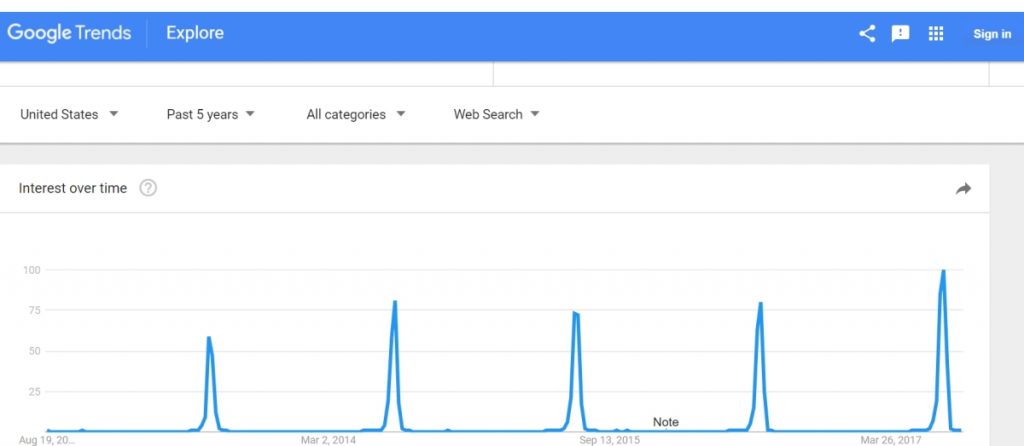
Google Trends for “NBA Summer League” term popularity
ESPN seemed to get its mix of ingredients just right.
- Great timing
The silly season is usually a bad time to break records. But the game between two great teams (Boston Celtics vs LA Lakers) and the duel between draft picks 2 and 3 (Lonzo Ball of the Lakers vs Jason Tatum of Celtics) presented opportunities for ESPN.
To hype the game, ESPN broadcasted a three-part documentary – Best of Enemies – exploring the Celtics/Lakers rivalry as part of its 30 for 30 series. The game itself was the most-watched Summer League game ever, with over 1.1million views on ESPN.
- Tons of shareable content dedicated to Lonzo Ball
Through content, ESPN were able to build a narrative thread that resonated with fans. It managed to maintain the hype surrounding the lead star, presenting Lonzo Ball as the future superstar and maybe as good as his father claims he is!
More than 1,000 articles and videos dedicated completely or partially to Lonzo or other Ball family members have also been created by ESPN.
- Big characters can add to the story
Lonzo Balls’ father, LaVar, was definitely one of the stars of the Summer League. You can dislike him, but the hype around his son is definitely his success. His opinions also get him airtime. On ESPN’s First Take Show, LaVar gets into a heated debate regarding his views on beating Michael Jordan in a game of one-on-one!
You may not have a Lonzo in your locker, or even want a LaVar on your team! But I hope you can take away some of the ingredients that created such a buzz around the Summer League and made it such a success.


